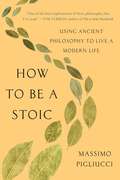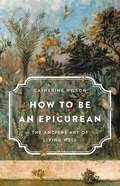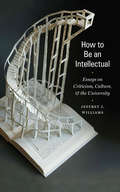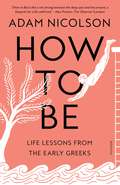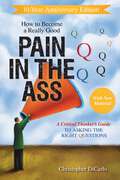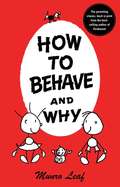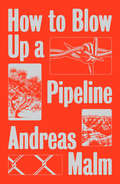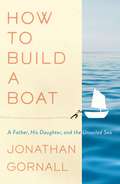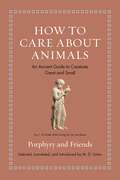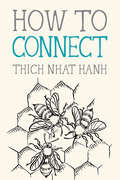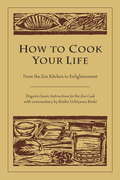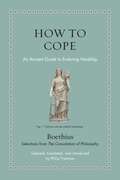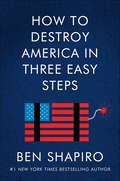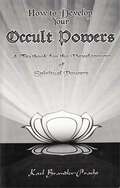- Table View
- List View
How to Be a Stoic: Using Ancient Philosophy to Live a Modern Life
by Massimo PigliucciAn engaging guide to how Stoicism--the ancient philosophy of Epictetus and Marcus Aurelius--can provide lessons for living in the modern worldWhenever we worry about what to eat, how to love, or simply how to be happy, we are worrying about how to lead a good life. No goal is more elusive. In How to Be a Stoic, philosopher Massimo Pigliucci offers Stoicism, the ancient philosophy that inspired the great emperor Marcus Aurelius, as the best way to attain it. Stoicism is a pragmatic philosophy that teaches us to act depending on what is within our control and separate things worth getting upset about from those that are not. By understanding Stoicism, we can learn to answer crucial questions: Should we get married or divorced? How should we bank in a world nearly destroyed by a financial crisis? How can we survive great personal tragedy? Whoever you are, Stoicism has something for you-and How to Be a Stoic is your essential guide.
How to Be an Epicurean: The Ancient Art of Living Well
by Catherine WilsonA leading philosopher shows that if the pursuit of happiness is the question, Epicureanism is the answer Epicureanism has a reputation problem, bringing to mind gluttons with gout or an admonition to eat, drink, and be merry. In How to Be an Epicurean, philosopher Catherine Wilson shows that Epicureanism isn't an excuse for having a good time: it's a means to live a good life. Although modern conveniences and scientific progress have significantly improved our quality of life, many of the problems faced by ancient Greeks -- love, money, family, politics -- remain with us in new forms. To overcome these obstacles, the Epicureans adopted a philosophy that promoted reason, respect for the natural world, and reverence for our fellow humans. By applying this ancient wisdom to a range of modern problems, from self-care routines and romantic entanglements to issues of public policy and social justice, Wilson shows us how we can all fill our lives with purpose and pleasure.
How to Be an Intellectual: Essays on Criticism, Culture, and the University
by Jeffrey J. WilliamsOver the past decade, Jeffrey J. Williams has been one of the most perceptive observers of contemporary literary and cultural studies. He has also been a shrewd analyst of the state of American higher education. How to Be an Intellectual brings together noted and new essays and exemplifies Williams’s effort to bring criticism to a wider publicHow to Be an Intellectual profiles a number of critics, drawing on a unique series of interviews that give an inside look at their work and careers. The book often looks at critical thought from surprising angles, examining, for instance, the history of modern American criticism in terms of its keywords as they morphed from sound to rigorous to smart. It also puts in plain language the political travesty of higher education policies that produce student debt, which, as Williams demonstrates, all too readily follow the model of colonial indenture, not just as a metaphor but in actual point of fact.How to Be an Intellectual tells a story of intellectual life since the culture wars. Shedding academic obscurity and calling for a better critical writing, it reflects on what makes the critic and intellectual—the accidents of careers, the trends in thought, the institutions that shape us, and politics. It also includes personal views of living and working with books.
How to Be: Life Lessons from the Early Greeks
by Adam NicolsonNicolson crafts a geography of the ancient world and a brilliant exploration of our connections to the past.What is the nature of things?What is justice? How can I be myself?How should we treat each other?Before the Greeks, the idea of the world was dominated by god-kings and their priests. Twenty-five hundred years ago, in a succession of small eastern Mediterranean harbor cities, a few heroic men and women decided to cast off mental subservience and apply their own thinking minds to the conundrums of life.These great innovators shaped the beginnings of western philosophy. Through the questioning voyager Odysseus, Homer explored how we might navigate our way through the world. Heraclitus, in Ephesus, was the first to consider the interrelatedness of things. Xenophanes of Colophon was the first champion of civility. On the Aegean island of Lesbos, the early lyric poets Sappho and Alcaeus asked themselves, “How can I be true to myself?” On Samos, Pythagoras imagined an everlasting soul and took his ideas to Italy, where they flowered again in surprising and radical forms.The award-winning writer Adam Nicolson travels with us through this transforming world and asks what light these ancient thinkers can throw on our deepest preconceptions. Enhanced with maps, photographs, and artwork, How to Be is an expedition into early ideas. Nicolson takes us to the dawn of investigative thought and makes the fundamental questions of the ancient philosophers new again. What are the principles of the physical world? How can we be good in it? And why do we continue to ask these questions? It is an enthralling, exhilarating journey.
How to Become a Really Good Pain in the Ass
by Christopher DicarloWhat can I know? What am I? Why am I here? How should I behave? What is to come of me? The way you answer these questions will tell you a lot about yourself. And if you ask others these questions, their answers will tell you a good deal about them, how they think, and what they value. Of course, if you persist in asking these questions, others may think you've become a really good pain in the ass. According to the author, you shouldn't be insulted by such a reaction, but treat it as a mark of distinction. For it means you've learned to think critically. In this witty, incisive guide to critical thinking the author provides you with the tools to allow you to question beliefs and assumptions held by those who claim to know what they're talking about. These days there are many people whom we need to question: politicians, lawyers, doctors, teachers, clergy members, bankers, car salesmen, and your boss. This book will empower you with the ability to spot faulty reasoning and, by asking the right sorts of questions, hold people accountable not only for what they believe but how they behave. By using this book you'll learn to analyze your own thoughts, ideas, and beliefs, and why you act on them (or don't). This, in turn, will help you to understand why others might hold opposing views. And the best way to change our own or others' behavior or attitudes is to gain greater clarity about underlying motives and thought processes. In a media-driven world of talking heads, gurus, urban legends, and hype, learning to think more clearly and critically, and helping others to do the same, is one of the most important things you can do.
How to Behave and Why
by Munro LeafHave you ever uncovered a hidden treasure of a book while browsing in some forgotten corner of a bookstore? I happened across How to Behave and Why in this fashion. Initially I was delighted by its bold red-and-black cover design, so simple and yet so arresting, and its charming stick-figure illustrations. It wasn't until I had read the book that I discovered its most enchanting feature: This book doesn't teach the most recent or fashionable etiquette of the day; it encourages a spirit of cooperation among people and a humanity that applies to societies the world over. This lesson is classic and timeless. I hope How to Behave and Why enchants you as it enchants me.
How to Blow Up a Pipeline
by Andreas MalmProperty will cost us the earthThe science on climate change has been clear for a very long time now. Yet despite decades of appeals, mass street protests, petition campaigns, and peaceful demonstrations, we are still facing a booming fossil fuel industry, rising seas, rising emission levels, and a rising temperature. With the stakes so high, why haven't we moved beyond peaceful protest?In this lyrical manifesto, noted climate scholar (and saboteur of SUV tires and coal mines) Andreas Malm makes an impassioned call for the climate movement to escalate its tactics in the face of ecological collapse. We need, he argues, to force fossil fuel extraction to stop--with our actions, with our bodies, and by defusing and destroying its tools. We need, in short, to start blowing up some oil pipelines.Offering a counter-history of how mass popular change has occurred, from the democratic revolutions overthrowing dictators to the movement against apartheid and for women's suffrage, Malm argues that the strategic acceptance of property destruction and violence has been the only route for revolutionary change. In a braided narrative that moves from the forests of Germany and the streets of London to the deserts of Iraq, Malm offers us an incisive discussion of the politics and ethics of pacifism and violence, democracy and social change, strategy and tactics, and a movement compelled by both the heart and the mind. Here is how we fight in a world on fire.
How to Build a Boat: A Father, His Daughter, and the Unsailed Sea
by Jonathan GornallPart ode to building something with one’s hands in the modern age, part celebration of the beauty and function of boats, and part moving father-daughter story, How to Build a Boat is a bold adventure.Once an essential skill, the ability to build a clinker boat, first innovated by the Vikings, can seem incomprehensible today. Yet it was the clinker, with its overlapping planks, that afforded us access to the oceans, and its construction has become a lost art that calls to the do-it-yourselfer in all of us. John Gornall heard the call. A thoroughly unskilled modern man, Gornall set out to build a traditional wooden boat as a gift for his newborn daughter. It was, he recognized, a ridiculously quixotic challenge for a man who knew little about woodworking and even less about boat-building. He wasn’t even sure what type of wood he should use, the tools he’d need, or where on earth he'd build the boat. He had much to consider…and even more to learn. But, undaunted, he embarked on a voyage of rediscovery, determined to navigate his way back to a time when we could fashion our future and leave our mark on history using only time-honored skills and the materials at hand. His journey began in East Anglia, on England’s rocky eastern coast. If all went according to plan, it would end with a great adventure, as father and daughter cast off together for a voyage of discovery that neither would forget, and both would treasure until the end of their days. How to Build a Boat celebrates the art of boat-building, the simple pleasures of working with your hands, and the aspirations and glory of new fatherhood. John Gornall “tells the inspiring story of how even the least skilled of us can make something wonderful if we invest enough time and love” (The Daily Mail) and taps into the allure of an ancient craft, interpreting it in a modern way, as tribute to the generations yet to come. “Both the book, and place, are magical” (The Sunday Telegraph).
How to Care about Animals: An Ancient Guide to Creatures Great and Small (Ancient Wisdom for Modern Readers)
by M. D. UsherAn entertaining and enlightening anthology of classical Greek and Roman writings on animals—and our vital relationships with themHow to Care about Animals is a fascinating menagerie of passages from classical literature about animals and the lives we share with them. Drawing on ancient writers from Aesop to Ovid, classicist and farmer M. D. Usher has gathered a healthy litter of selections that reveal some of the ways Greeks and Romans thought about everything from lions, bears, and wolves to birds, octopuses, and snails—and that might inspire us to rethink our own relationships with our fellow creatures. Presented in lively new translations, with the original texts on facing pages, these pieces are filled with surprises—anticipating but also offering new perspectives on many of our current feelings and ideas about animals.Here, Porphyry makes a compelling argument for vegetarianism and asserts that the just treatment of animals makes us better people; Pliny the Elder praises the virtuosity of songbirds and the virtuousness of elephants; Plutarch has one of Circe’s pigs from the Odyssey make a serio-comic case for the dignity of the beasts of the field; Aristotle puts the study of animals on par with anthropology; we read timeless Aesopian fables, including “The Hen That Laid the Golden Egg” and “The Fox and the Grapes”; and there is much, much more.A Noah’s Ark of a book, How to Care about Animals is guaranteed to charm and inspire anyone who loves animals.
How to Connect (Mindfulness Essentials #8)
by Thich Nhat HanhWe can restore our inherent connection to nature, each other, our ancestors, and ourselves, and remember our fundamental gift of belonging. The eighth book in the bestselling Mindfulness Essentials series, a back-to-basics collection from world-renowned Zen master Thich Nhat Hanh that introduces everyone to the essentials of mindfulness practice. "We are here to awaken from the illusion of our separateness."—Thich Nhat HanhWith our world experiencing the deep effects of loneliness, environmental detachment, and digital overload, this pocket-sized How To book reminds us of our crucial need to connect to ourselves, our ancestors, and our planet. Written with characteristic simplicity and kindness, these wise meditations teach us how to remember, at any time, our fundamental gift of belonging. Illustrated with playful sumi-ink drawings by California artist Jason DeAntonis.
How to Cook Your Life: From the Zen Kitchen to Enlightenment
by Kosho Uchiyama Roshi DogenIn the thirteenth century, Zen master Dogen—perhaps the most significant of all Japanese philosophers, and the founder of the Japanese Soto Zen sect—wrote a practical manual of Instructions for the Zen Cook. In drawing parallels between preparing meals for the Zen monastery and spiritual training, he reveals far more than simply the rules and manners of the Zen kitchen; he teaches us how to "cook," or refine our lives. In this volume Kosho Uchiyama Roshi undertakes the task of elucidating Dogen's text for the benefit of modern-day readers of Zen. Taken together, his translation and commentary truly constitute a "cookbook for life," one that shows us how to live with an unbiased mind in the midst of our workaday world.
How to Cope: An Ancient Guide to Enduring Hardship (Ancient Wisdom for Modern Readers)
by BoethiusA vivid and accessible new translation of essential selections from Boethius&’s Consolation of Philosophy—a moving classic about facing life&’s worst events with courage and hopeWhat do you do when your life has fallen apart? Fifteen hundred years ago, a Roman nobleman named Boethius (ca. 480–524 CE) asked this question as he was sitting in a prison cell waiting to die, accused—probably unjustly—of treason. Boethius had been a rich and powerful man with all a person could want in life, but now he had lost everything. Shaken, he wondered how such terrible misfortune could have happened to him and why life was so unfair. When Philosophy herself appears in his cell and confronts Boethius, the conversation that follows between the two on the nature of evil and why humans suffer is as powerful and inspiring today as it was to its first readers. In How to Cope, Philip Freeman presents a lively modern translation of essential selections from Boethius&’s classic, complete with an introduction and the original Latin on facing pages.This translation vividly captures Boethius&’s journey from bitterness and anger to reconciliation and peace, showing how ancient philosophy, especially Stoicism, can help readers deal with adversity in their own lives. The book reveals the qualities that have made The Consolation of Philosophy one of the most popular and influential works of classical and world literature, and an inspiration to countless writers, including Thomas Aquinas, Dante, and Chaucer.
How to Destroy America in Three Easy Steps
by Ben ShapiroA NEW YORK TIMES BESTSELLER!A growing number of Americans want to tear down what it’s taken us 250 years to build—and they’ll start by canceling our shared history, ideals, and culture.Traditional areas of civic agreement are vanishing. We can’t agree on what makes America special. We can’t even agree that America is special. We’re coming to the point that we can’t even agree what the word America itself means. “Disintegrationists” say we’re stronger together, but their assault on America’s history, philosophy, and culture will only tear us apart.Who are the disintegrationists? From Howard Zinn’s A People’s History of the United States to the New York Times’ 1619 project, many modern analyses view American history through the lens of competing oppressions, a racist and corrupt experiment from the very beginning. They see American philosophy as a lie – beautiful words pasted over a thoroughly rotted system. They see America’s culture of rights as a façade that merely reinforces traditional hierarchies of power, instead of being the only culture that guarantees freedom for individuals.Disintegrationist attacks on the values that built our nation are insidious because they replace each foundational belief, from the rights to free speech and self-defense to the importance of marriage and faith communities, with nothing more than an increased reliance on the government. This twisted disintegrationist vision replaces the traditional “unionist” understanding that all Americans are united in a shared striving toward the perfection of universal ideals.How to Destroy America in Three Easy Steps shows that to be a cohesive nation we have to uphold foundational truths about ourselves, our history, and reality itself—to be unionists instead of disintegrationists. Shapiro offers a vital warning that if we don’t recover these shared truths, our future—our union—as a great country is threatened with destruction.
How to Develop Your Occult Powers: A Textbook for the Development of Spiritual Powers
by Karl Brandler-PrachtKarl Brandler-Pracht, author of How to Develop Your Occult Powers, presents a comprehensive and detailed textbook in developing your occult knowledge, thus leading to an empowering of spiritual gifts and abilities to serve your fellowman. The spiritual insight gained in the exercises contained in the reading will empower the reader to fulfill his divine purpose, not only in gaining self-discipline, but also in allowing that discipline (as a disciple) to radiate outwards to serve mankind. The reader is led to soul-searching within himself through instructions that connect two great yogic systems, one which deals with the physiological part of a human being, while the other focuses on the psychic development. In this process, you will learn from the beginning stage of an apprentice, spiritual exercises that include the power of thoughts and their manifestation, the importance of breathing, and the use of magnetism. The reader then moves on to journeyman, which requires an higher ethical development, to learn the value of introspection and liberation through higher exercises to achieve an harmonious lifestyle. In implementing these higher exercises, you will be taught the power of the Od, the Infinite subtle substance that each human body produces and emanates, and how you can increase this vital energy to manifest with power in your spiritual abilities to serve others. In the journeyman&’s exercises, such topics that are addressed include telepathy, higher breathing techniques, idealistic monism (supremacy of one idea), dreams, clairvoyance and clairaudience, psychometry (history of an object), and the healing power of magnetism. In the final development, the reader who has attained the highest ethical level is given the last key, the tattvas, to understand and sell all things through the &“inner eye&” and thus become a Master. As a Master, he has overcome the world, become one with the all-encompassing love, and lives only for a higher purpose — to use his power solely for the well-being of his fellowman. With his feet, he stands on the earth, but with his head, he rises into heaven. Now he is able to give those in need the enlightenment which he himself received when he needed it. How to Develop Your Occult Powers is a unique process of spiritual development and exercises to enable the individual to attain the highest level of empowerment for himself and for the benefit of those around him.
How to Die: An Ancient Guide to the End of Life
by Seneca James S. RommTimeless wisdom on death and dying from the celebrated Stoic philosopher Seneca"It takes an entire lifetime to learn how to die," wrote the Roman Stoic philosopher Seneca (c. 4 BC–65 AD). He counseled readers to "study death always," and took his own advice, returning to the subject again and again in all his writings, yet he never treated it in a complete work. How to Die gathers in one volume, for the first time, Seneca's remarkable meditations on death and dying. Edited and translated by James S. Romm, How to Die reveals a provocative thinker and dazzling writer who speaks with a startling frankness about the need to accept death or even, under certain conditions, to seek it out. Seneca believed that life is only a journey toward death and that one must rehearse for death throughout life. Here, he tells us how to practice for death, how to die well, and how to understand the role of a good death in a good life. He stresses the universality of death, its importance as life's final rite of passage, and its ability to liberate us from pain, slavery, or political oppression. Featuring beautifully rendered new translations, How to Die also includes an enlightening introduction, notes, the original Latin texts, and an epilogue presenting Tacitus's description of Seneca's grim suicide.
How to Do Comparative Theology (Comparative Theology: Thinking Across Traditions)
by Francis X. Clooney, S.J., and Klaus Von StoschFor a generation and more, the contribution of Christian theology to interreligious understanding has been a subject of debate. Some think of theological perspectives are of themselves inherently too narrow to support interreligious learning, and argue for an approach that is neutral or, on a more popular level, grounded simply open-minded direct experience. In response, comparative theology argues that theology, as faith seeking understanding, offers a vital perspective and a way of advancing interreligious dialogue, aided rather than hindered by commitments; theological perspectives can both complement and step beyond the study of religions by methods detached and merely neutral. Thus comparative theology has been successful in persuading many that interreligious learning from one faith perspective to another is both possible and worthwhile, and so the work of comparative theology has become more recognized and established globally. With this success there has come to the fore new challenges regarding method: How does one do comparative theological work in a way that is theologically grounded, genuinely open to learning from the other, sophisticated in pursuing comparisons, and fruitful on both the academic and practical levels? How To Do Comparative Theology therefore contributes to the maturation of method in the field of comparative theological studies, learning across religious borders, by bringing together essays drawing on different Christian traditions of learning, Judaism and Islam, Hinduism and Buddhism, the wisdom of senior scholars, and also insights from a younger generation of scholars who have studied theology and religion in new ways, and are more attuned to the language of the “spiritual but not religious.” The essays in this volume show great diversity in method, and also—over and again and from many angles—coherence in intent, a commitment to one learning from the other, and a confidence that one’s home tradition benefits from fair and unhampered learning from other and very different spiritual and religious traditions. It therefore shows the diversity and coherence of comparative theology as an emerging discipline today.
How to Do Things with Art
by Dorothea Von HantelmannPart of JRP|Ringer's innovative Documents series, published with Les Presses du Réel and dedicated to critical writings, this publication comprises a unique collection of interviews by Hans Ulrich Obrist mapping the development of the curatorial field--from early independent curators in the 1960s and 70s and the experimental institutional programs developed in Europe and the U.S. through the inception of Documenta and the various biennales and fairs--with pioneering curators Anne D'Harnoncourt, Werner Hoffman, Jean Leering, Franz Meyer, Seth Siegelaub, Walter Zanini, Johannes Cladders, Lucy Lippard, Walter Hopps, Pontus Hulten and Harald Szeemann. Speaking of Szeemann on the occasion of this legendary curator's death in 2005, critic Aaron Schuster summed up, "the image we have of the curator today: the curator-as-artist, a roaming, freelance designer of exhibitions, or in his own witty formulation, a 'spiritual guest worker'... If artists since Marcel Duchamp have affirmed selection and arrangement as legitimate artistic strategies, was it not simply a matter of time before curatorial practice--itself defined by selection and arrangement--would come to be seen as an art that operates on the field of art itself?"
How to Do Things with Emotions: The Morality of Anger and Shame across Cultures
by Owen FlanaganAn expansive look at how culture shapes our emotions—and how we can benefit, as individuals and a society, from less anger and more shameThe world today is full of anger. Everywhere we look, we see values clashing and tempers rising, in ways that seem frenzied, aimless, and cruel. At the same time, we witness political leaders and others who lack any sense of shame, even as they display carelessness with the truth and the common good. In How to Do Things with Emotions, Owen Flanagan explains that emotions are things we do, and he reminds us that those like anger and shame involve cultural norms and scripts. The ways we do these emotions offer no guarantee of emotionally or ethically balanced lives—but still we can control and change how such emotions are done. Flanagan makes a passionate case for tuning down anger and tuning up shame, and he observes how cultures around the world can show us how to perform these emotions better.Through comparative insights from anthropology, psychology, and cross-cultural philosophy, Flanagan reveals an incredible range in the expression of anger and shame across societies. He establishes that certain types of anger—such as those that lead to revenge or passing hurt on to others—are more destructive than we imagine. Certain forms of shame, on the other hand, can protect positive values, including courage, kindness, and honesty. Flanagan proposes that we should embrace shame as a uniquely socializing emotion, one that can promote moral progress where undisciplined anger cannot.How to Do Things with Emotions celebrates the plasticity of our emotional responses—and our freedom to recalibrate them in the pursuit of more fulfilling lives.
How to Do Things with Sensors (Forerunners: Ideas First)
by Jennifer GabrysAn investigation of how-to guides for sensor technologies Sensors are increasingly common within citizen-sensing and DIY projects, but these devices often require the use of a how-to guide. From online instructional videos for troubleshooting sensor installations to handbooks for using and abusing the Internet of Things, the how-to genres and formats of digital instruction continue to expand and develop. As the how-to proliferates, and instructions unfold through multiple aspects of technoscientific practices, Jennifer Gabrys asks why the how-to has become one of the prevailing genres of the digital. How to Do Things with Sensors explores the ways in which things are made do-able with and through sensors and further considers how worlds are made sense-able and actionable through the instructional mode of citizen-sensing projects.Forerunners: Ideas FirstShort books of thought-in-process scholarship, where intense analysis, questioning, and speculation take the lead
How to Do Things with Words
by J. L. Austin J. O. Urmson Marina SbisàJohn L. Austin was one of the leading philosophers of the twentieth century. The William James Lectures presented Austin's conclusions in the field to which he directed his main efforts on a wide variety of philosophical problems. These talks became the classic How to Do Things with Words
How to Do Things with Words
by J. L. AustinIn this seminal series of lectures by the noted British philosopher, J.L. Austin explores the profound ways in which language is not just a vehicle for conveying information but also a tool for performing actions. He introduces the concept of the performative utterance -- later called dubbed a speech-act -- which are utterances that not only convey meaning but also have the power to bring about changes in the world. The book also delves into the complexities of language, meaning, and context, highlighting how linguistic conventions and social norms shape our understanding of words. Austin's work challenges conventional views on language, emphasizing that words have the power to do things and not just describe things.
How to Do Things with Words: Second Edition (Oxford Paperbacks Ser. #1)
by J. L. AustinJohn L. Austin was one of the leading philosophers of the twentieth century. The William James Lectures presented Austin’s conclusions in the field to which he directed his main efforts on a wide variety of philosophical problems. These talks became the classic How to Do Things with Words. For this second edition, the editors have returned to Austin’s original lecture notes, amending the printed text where it seemed necessary. Students will find the new text clearer, and, at the same time, more faithful to the actual lectures. An appendix contains literal transcriptions of a number of marginal notes made by Austin but not included in the text. Comparison of the text with these annotations provides new dimensions to the study of Austin’s work.
How to Do the Right Thing: An Ancient Guide to Treating People Fairly (Ancient Wisdom for Modern Readers)
by SenecaHow ancient Stoicism can help teach us to treat others—and ourselves—more fairly and mercifully There are times when we&’ve all felt that we haven&’t been treated as we deserve—that we&’ve been misjudged, shortchanged, or given a raw deal. And, at one time or another, other people have probably felt that we&’ve treated them just as unfairly. How to Do the Right Thing draws on the principles of ancient Stoicism as articulated by the Roman statesman and philosopher Seneca to help readers better navigate one of the most important practical questions of daily life—how to do right by others.Starting from the virtue of magnanimity—the opposite of small-mindedness—How to Do the Right Thing draws together lessons from Seneca&’s writings that stress the importance of calm and clear thinking, of judging oneself fairly before judging others, and of cutting people slack, with a bias toward mercy—all delivered in crisp and lively new translations, and with the original Latin on facing pages.
How to Dream (Mindfulness Essentials)
by Thich Nhat HanhIn the final book of the best-selling Mindfulness Essentials series, Zen Master Thich Nhat Hanh shows us how to realize our dreams in this very moment.We all want our lives to be useful and meaningful. The aspiration to transform suffering—our own, each other&’s, and the Earth&’s—can give us the energy we need to continue on a wholesome path. In How to Dream, Thich Nhat Hanh explains how to let our deep desire nourish us and, in turn, how to keep that desire alive. With inspiring illustrations throughout, this pocket-sized book explains how to:• Get in touch with our deepest dream• Live our dream in every moment of daily life• Keep our dream alive with the help of a community• Protect our dream from the dampening effects of our fast-paced modern life• Direct energy towards lasting personal, social, and political changeIf our aspiration is lost, depleted, or if we&’ve slowly let it go, we must rekindle it. Whatever our role in society—activist, businessperson, teacher, parent, or politician—we can live into our deep aspiration and change the direction of civilization. And together, as a community with a collective aspiration, we have the energy to realize our dream.
How to Drink: A Classical Guide to the Art of Imbibing (Ancient Wisdom for Modern Readers)
by Vincent ObsopoeusA spirited new translation of a forgotten classic, shot through with timeless wisdom Is there an art to drinking alcohol? Can drinking ever be a virtue? The Renaissance humanist and neoclassical poet Vincent Obsopoeus (ca. 1498–1539) thought so. In the winelands of sixteenth-century Germany, he witnessed the birth of a poisonous new culture of bingeing, hazing, peer pressure, and competitive drinking. Alarmed, and inspired by the Roman poet Ovid's Art of Love, he wrote The Art of Drinking (De Arte Bibendi) (1536), a how-to manual for drinking with pleasure and discrimination. In How to Drink, Michael Fontaine offers the first proper English translation of Obsopoeus's text, rendering his poetry into spirited, contemporary prose and uncorking a forgotten classic that will appeal to drinkers of all kinds and (legal) ages.Arguing that moderation, not abstinence, is the key to lasting sobriety, and that drinking can be a virtue if it is done with rules and limits, Obsopoeus teaches us how to manage our drinking, how to win friends at social gatherings, and how to give a proper toast. But he also says that drinking to excess on occasion is okay—and he even tells us how to win drinking games, citing extensive personal experience.Complete with the original Latin on facing pages, this sparkling work is as intoxicating today as when it was first published.
